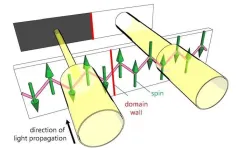(Press-News.org) Scientists have identified a protein that blocks the activity of bone-forming cells (osteoblasts) by stopping them from maturing during the journey to sites of bone formation, a new study has found.
In a paper published in Communications Biology today (Friday 11 October 2024), a team of researchers led by Dr Amy Naylor and Professor Roy Bicknell along with their team including Dr Georgiana Neag from the University of Birmingham have found that protein CLEC14A, which is found on blood vessel cells called endothelial cells in bone, block the function of bone development cells called osteoblasts.
Endothelial cell’s job during bone development is to transport immature osteoblasts to sites where new bone is needed. However, when the protein CLEC14A is also present on the outside of the endothelial cell, osteoblasts are prevented from maturing to the point where they can form bone tissue.
In this study, osteoblast cells were taken from transgenic mice that either have been bred to produce CLEC14A or not. The osteoblasts were subsequently used in vitro in an induction solution, and the team found that cells taken from the protein-free mice reached maturation after four (4) days while those in the presence of CLEC14A matured eight (8) days later. Furthermore, the CLEC14A-free samples saw a significant increase in mineralised bone tissue at day 18 in the study.
Dr Amy Naylor, Associate Professor in the School of Infection, Inflammation and Immunology at the University of Birmingham said:
“In the last decade, a specific type of blood vessel cell was identified within bones. This blood vessel is called ‘type-H’ and is responsible for guiding bone-forming osteoblasts to the places where bone growth is needed. Now we have discovered that a protein called CLEC14A can be found on the surface of type-H blood vessel cells.
“In the experiments we performed, when CLEC14A protein is present the osteoblasts that were sharing a ride on the endothelial cells produce less bone. Conversely, when the protein is removed, they produce more bone.
“This additional understanding of how blood vessel cells control bone-forming osteoblasts under normal, healthy conditions provide an avenue to develop treatments for patients who have insufficient bone formation, for example in patients with fractures that do not heal, osteoporosis or with chronic inflammatory diseases.”
Lucy Donaldson, Director for Research & Health Intelligence at Versus Arthritis:
“We know that poor bone formation is an important driver of bone damage in osteoporosis and autoimmune inflammatory arthritis. This can lead to disability, pain, and fatigue which impacts people’s lives in many ways, including their ability to work, the time they spend with family and friends, and their wellbeing.
We're proud to have funded Dr Naylor's research which has improved our understanding of bone formation and remodelling. We hope these findings will eventually lead to new treatment approaches for people with musculoskeletal conditions.
Whilst these findings are promising, we won’t rest until everyone with arthritis has access to treatments and interventions that let them live the lives they choose.”
END
Protein blocking bone development could hold clues for future osteoporosis treatment
2024-10-11
ELSE PRESS RELEASES FROM THIS DATE:
A new method makes high-resolution imaging more accessible
2024-10-11
A classical way to image nanoscale structures in cells is with high-powered, expensive super-resolution microscopes. As an alternative, MIT researchers have developed a way to expand tissue before imaging it — a technique that allows them to achieve nanoscale resolution with a conventional light microscope.
In the newest version of this technique, the researchers have made it possible to expand tissue 20-fold in a single step. This simple, inexpensive method could pave the way for nearly any biology lab to perform nanoscale imaging.
“This democratizes imaging,” says Laura Kiessling, the Novartis Professor ...
Tiny magnetic discs offer remote brain stimulation without transgenes
2024-10-11
Novel magnetic nanodiscs could provide a much less invasive way of stimulating parts of the brain, paving the way for stimulation therapies without implants or genetic modification, MIT researchers report.
The scientists envision that the tiny discs, which are about 250 nanometers across (about 1/500 the width of a human hair), would be injected directly into the desired location in the brain. From there, they could be activated at any time simply by applying a magnetic field outside the body. The new particles could quickly find applications in biomedical research, and eventually, after sufficient testing, ...
Illuminating quantum magnets: Light unveils magnetic domains
2024-10-11
When something draws us in like a magnet, we take a closer look. When magnets draw in physicists, they take a quantum look.
Scientists from Osaka Metropolitan University and the University of Tokyo have successfully used light to visualize tiny magnetic regions, known as magnetic domains, in a specialized quantum material. Moreover, they successfully manipulated these regions by the application of an electric field. Their findings offer new insights into the complex behavior of magnetic materials at the quantum level, paving the way for future technological advances.
Most of us are familiar with magnets that stick to metal surfaces. But what about those that do not? Among ...
Different types of teenage friendships critical to wellbeing as we age, scientists find
2024-10-11
Being a teenager is hard, confusing — and crucially important. Scientists studying teenage socializing have found that teenaged friendships could lay essential foundations for wellbeing in later life, and that not just the kinds of friendships teenagers experience but the timing of those friendships is critical.
“A teen’s perception of how broadly socially accepted they are by their peers in early adolescence is particularly influential in predicting adult wellbeing,” said Emily Shah of the University of Arkansas, first author of the article in Frontiers in Developmental Psychology. “Conversely, in late adolescence, the quality of their more ...
Hawaii distillery project wins funding from Scottish brewing and distilling award
2024-10-11
Hawaii could soon be welcoming a new distillery after a postgraduate student at Scotland’s Heriot-Watt University won a prestigious entrepreneurial award.
Canadian student Ethan Wang, 42, wants to open a new distillery on Hawaii’s scenic volcanic island of Maui and said he was in “total shock” after winning cash and support from an industry membership organisation to help make his idea happen.
The award, called the Worshipful Company of Distillers’ Entrepreneurship Award, is designed to help students apply their science in the real world and is run jointly by Heriot-Watt’s respected International Centre for Brewing and Distilling and The Worshipful Company ...
Trinity researchers find ‘natural killer’ cells that live in the lung are ready for a sugar rush
2024-10-11
Trinity researchers find ‘natural killer’ cells that live in the lung are ready for a sugar rush
Trinity College Dublin researchers, based at St James’s Hospital have provided important insights into the behaviour and metabolic function of a previously largely unknown, but crucial ‘natural killer’ (NK) immune cell resident in the lungs. Their findings, published today [Thursday, 10th October 2024] in the journal: Proceedings of the National Academy of Sciences (PNAS) provide ...
$7 Million from ARPA-H to tackle lung infections through innovative probiotic treatment
2024-10-11
University of California San Diego and University of California Berkeley researchers have been awarded up to $7 million from the Advanced Research Projects Agency for Health (ARPA-H) to conduct research under the PROTECT project — Pro/Prebiotic Regulation for Optimized Treatment and Eradication of Clinical Threats. The project targets pathogens such as Pseudomonas aeruginosa and potentially Staphylococcus aureus, which pose significant health risks for individuals with cystic fibrosis and those dependent on respirators. PROTECT co-principal investigators are ...
Breakdancers may risk ‘headspin hole’ caused by repetitive headspins, doctors warn
2024-10-10
Breakdancers may be at risk of developing a condition caused by repeatedly doing a cardinal move of their practice and performance—the headspin—warn doctors in the journal BMJ Case Reports.
Dubbed the ‘headspin hole,’ or ‘breakdance bulge,’ the condition is unique to breakdancers, and appears as a protruding lump on the scalp, often accompanied by hair loss and tenderness.
Breakdancers are particularly prone to injuries because of the complexities and physical demands of the moves, note the authors. Sprains, strains, and tendinitis are particularly common. Head and brain injuries, including subdural haematomas (pooling ...
Don’t rely on AI chatbots for accurate, safe drug information, patients warned
2024-10-10
Patients shouldn’t rely on AI powered search engines and chatbots to always give them accurate and safe information on drugs, conclude researchers in the journal BMJ Quality & Safety, after finding a considerable number of answers were wrong or potentially harmful.
What’s more, the complexity of the answers provided might make it difficult for patients to fully understand them without a degree level education, add the researchers.
In February 2023, search engines underwent a significant shift thanks to the introduction ...
Nearly $10M investment will expand and enhance stroke care in Minnesota, South Dakota
2024-10-10
DALLAS, October 10, 2024 — Across the United States, more than 90% of stroke patients have some form of disability as a result and more than 11% experience a second stroke within a year. This risk weighs particularly heavily on people living in rural areas, who may face challenges accessing health care.
The American Heart Association, with support from The Leona M. and Harry B. Helmsley Charitable Trust, has committed $4.7 million in Minnesota and $5.05 million in South Dakota to strengthen the full spectrum of stroke care across ...


